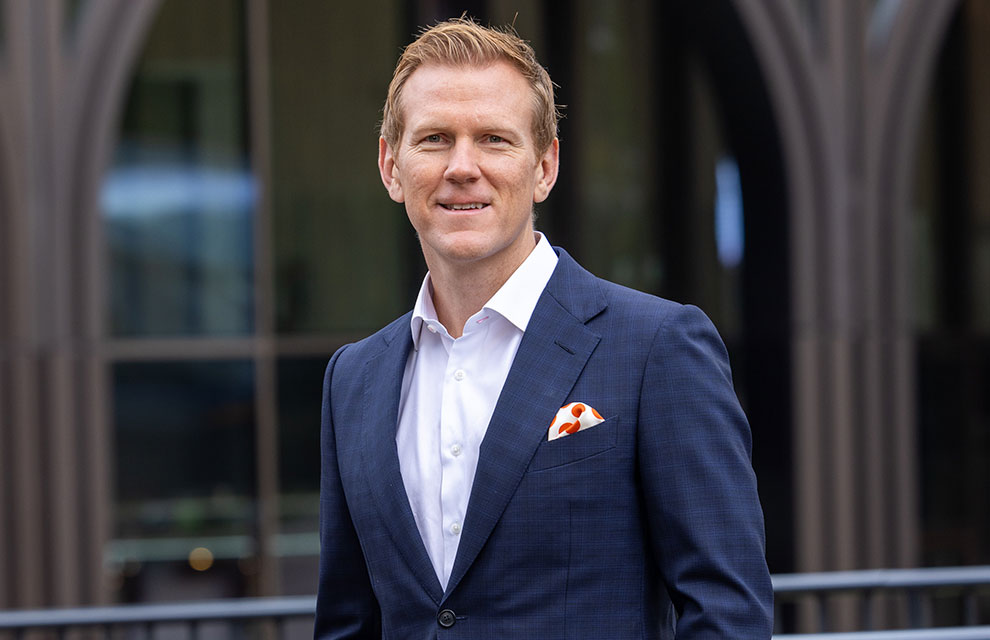The increasing sophistication on the buy side is in full swing, from insourcing fund management and central treasury functions, to furthering convergence with the sell side.
Notably, there has been a marked evolution on the buy side in terms of priorities, sophistication, and function. Over the past decade, J.P. Morgan has observed a significant increase in lendable assets which have taken residence within global securities lending programmes, with demand to borrow these assets remaining relatively stable.
“For institutions such as J.P. Morgan to continue to meet our clients’ needs, it's important that we evolve our product away from just vanilla discretionary securities lending,” explains Ed Bond, global head of Trading Services at J.P. Morgan.
Further, J.P. Morgan has seen an increase in non-custody securities lending, alongside a growing trend in activities designed to increase returns and optimise investment outcomes. This reflects a strategic shift among clients, who are increasingly evaluating and selecting providers based on specific capabilities in alpha generation, rather than defaulting to existing custodial arrangements. This approach underscores the importance of aligning with partners who can deliver bespoke solutions that meet diverse investment objectives.
Acting as a catalyst, the Uncleared Margin Rules (UMR) brought a more focused view on sources and uses of collateral for J.P. Morgan’s buy side clients. In turn, this raised questions around how to optimise and, according to Bond, fundamentally drove a desire to build in-house central treasury functions or teams.
Essentially, clients are internalising processes and beginning to take a more holistic view of inventory management and collateral use.
Two sides of the same financing coin
The route to sophistication is an important one. For Bond, there is no better example of this than in Australia.
The Australian superannuation fund industry has undergone significant consolidation over the past few years, a trend likely to continue in the medium term. Bond highlights an increasing amount of capital now distributed across fewer asset owners in the market. This shift has increased the fiscal responsibility of these asset owners, further bolstered by government initiatives aimed at protecting the integrity of the financial system.
Firms have had to boost their internal treasury functions and inventory management abilities to ensure that they can maximise performance and allocate the increasing amount of capital, while also adhering to any regulatory changes that occur. Bond explained: “In a world where capital continues to grow, we see a trend where the buy side are building out their international presence; as an example, APAC institutions opening up desks in London or New York."
He adds: “That clearly helps in an environment where we're seeing a shortened settlement cycle. It also helps that the buy side is building out relationships bilaterally. It enables them to have relationships with sell side institutions and trading counterparts across financial centres globally, and that, in turn, will generate flow and idea generation.”
Bond also highlights an increase in sell side experts moving to work for buy side institutions, while the buy side continue to build out teams through their internal talent programmes to support central treasury functions.
In his view, the sell side and the buy side are two sides of the same securities financing coin within the securities financing ecosystem. “With the expertise that the buy side has been investing in and building out, they're having sophisticated dialogue with the sell side,” he adds, “the most sophisticated buy side clients understand the binding constraints of the sell side.”
In other words, buy side clients are now more acutely aware of the requirements of the sell side and are able to direct and structure securities financing trades. They are also in a better position, in Bond’s experience, to understand, price, and build these relationships directly. He believes this expertise, along with having larger teams, has enabled the buy side to be more active directly with the sell side, therefore generating alpha for them.
“In summary, UMR, increased balance sheet management, and talent acquisition, both internal and external, have driven a convergence between collateral and financing,” Bond highlights. “There's a convergence between sell side and buy side, and there's a convergence between what's historically collateral management and securities financing.”
According to Bond, this convergence has prompted firms to focus on optimising their use of collateral and securities. The goal is to “get the right asset in the right place at the right time” to generate returns and support the institution’s wider investment strategy. Additionally, buy side participants aim to build out relationships across the financing ecosystem, including sell side and buy side participants, all through an inventory management process.
To build or to buy
The trend towards insourcing has become increasingly prominent among buy side market participants, particularly in response to regulatory changes like UMR.
UMR regulation was “a real change”, as it required, for the first time, many firms to post margin. This shift has compelled buy side firms to internalise processes to better manage their collateral needs. Although UMR is directed at the derivatives market, it has a meaningful impact on the use of collateral for securities lending participants.
Those impacted the most are predominantly buy side entities. Under UMR, initial margin (IM) is commonly a two-way exchange with liquidity and funding implications. Therefore, buy side firms now need access to collateral that is eligible for IM, and need to check whether their counterpart is in agreement on the type of collateral. Historically, variation margin has been posted as cash, whereas regulatory IM is generally non-cash collateral.
Due to the move from cash to an increase in non-cash, firms have increasingly needed to review what non-cash collateral they should be posting. It also presents a question around the value of a security and its funding cost. Firms have been looking at alternate routes and other collateral that can be posted, and J.P. Morgan is now able to support, as an example, posting equities as margin.
“We've seen Archegos Capital Management collapse, the UK gilt crisis, the change through Covid-19, and the vendor dependencies that came out of that, as well as the Silicon Valley Bank event — they all highlighted limitations around liquidity, and that all overlaps with a sustained period of interest rate hikes,” Bond comments. “Those factors combined have really driven an insourcing of some functions to ensure that firms have a clear and better understanding about how they are being optimal in the use of their collateral.”
Inventory management is now seeing the buy side using securities to fulfil certain obligations, to generate alpha, or for a number of other purposes. Bond suggests that the industry has come a long way from using discretionary securities lending to generate returns to pay custody, to a much more sophisticated, holistic inventory management view, fulfilling obligations and seeking to achieve alternate routes of revenue accretion.
“We've had to focus on developing our product to make sure that as the overall lending supply has increased, we've captured as much of that relatively stable borrower demand as possible,” Bond notes. “And to do that, you have to differentiate, build products, and provide more routes to market in order to generate value for the client.”
Unique value proposition
Speaking to Securities Finance Times, Bond analysed the core challenges facing the buy side in relation to securities lending and collateral management, and how this is shaping their development decisions.
Expectedly, regulatory changes form one of the concerns facing firms. Bond highlights the increasing number of firms posting margin through the UMR regulation. “Firms are trying to determine which assets to use to meet obligations — they therefore need to understand the fair value of collateral and the liquidity of their assets,” he explains.
Underpinning all of this is data — having comprehensive access to data and the ability to aggregate various credit support annexes (CSAs) and funding requirements ensures that, at any point in time, “they can make optimal decisions around which security to use to fulfil specific obligations”, Bond confirms. He believes that this is increasingly complex and is not limited to the buy side, but also “applies across the financing industry”.
In navigating the changing landscape for buy side firms, J.P. Morgan’s Trading Services business is positioned to provide support. Bond highlights the firm's distinctive structure, where three independent global businesses — Agency Securities Finance, Collateral Management, and Triparty — are integrated under the Trading Services umbrella, allowing J.P. Morgan to offer a suite of services tailored to the needs of its clients.
“Our aim has been to bring these three components together to provide a platform style of solutions for our clients,” Bond notes. “We want to be able to provide a range of solutions to our clients, as well as improved connectivity, and the analytics to support their decision making.”
To help buy side clients’ needs further, J.P. Morgan has invested and built out its Collateral Transport product. It is a mobilisation service that utilises J.P. Morgan’s securities lending infrastructure to assist clients in managing the mobilisation of their assets from custody accounts into Collateral Management or Triparty services, as well as handling the recourse substitution process for sales. Importantly, it collaborates with clients to support the use of assets as collateral, helping to better determine their intrinsic value in the lending market.
He adds: “Through this transport mechanism, we have been enhancing our ability to work with clients to direct collateral more optimally, meeting their various requirements.”
Looking forward
J.P. Morgan has much underway over the coming 12 months, including continued work on the Collateral Transport business — the firm aims to review the ability for clients to auto-select assets from custody, based on eligibility, preferences, and costs, evolving the holistic inventory management optimisation model. The key focus will be further enhancing this process to provide real-time insights and recommendations, ensuring optimal asset allocation.
Within J.P. Morgan’s Trading Services is also a digital product unit that is run independently and supports a platform known as the Tokenized Collateral Network (TCN). TCN uses the firm’s private permissioned blockchain, Kinexys Digital Assets, which enables clients to post assets to a collateral receiver without the need for physical movement, supporting an accelerated settlement process with less friction. According to Bond, Tokenisation will continue to be a focus for the business.
Bond explains: “Tokenisation of real world assets is gaining momentum. It's an area in which we've invested and continue to invest in. We work with both the buy side and sell side to develop use cases, and expand the participants on our network. Additionally, we are focused on connecting our Triparty systems to other digital platforms to enhance the financing of digital assets.”
This is an area of growth and development for 2025, and one that is very relevant to the suite of products within Trading Services and securities finance through Triparty, Agency Securities Finance, and Collateral Management.
In conclusion, Bond says: “We will continue to work with our clients to make sure that we can meet their needs, and we need to do that through understanding their liquidity, treasury needs, and the evolution of those over time, so that we can continue to innovate and partner with them. Our commitment to integrating automation into our services, through the likes of digitised CSA review and upload capabilities, ensures that we remain at the forefront of innovation, providing clients with the tools they need to succeed.
“Partnership and product evolution to support the buy side in growing their business in an optimal way is our focus right now, and will remain so through this year.”
← Previous interview
PASLA
Stephen Howard
Next interview →
S&P Global Market Intelligence
Scott Brown and Johan Rasmusson
 Image: Andrew Davis
Image: Andrew Davis 